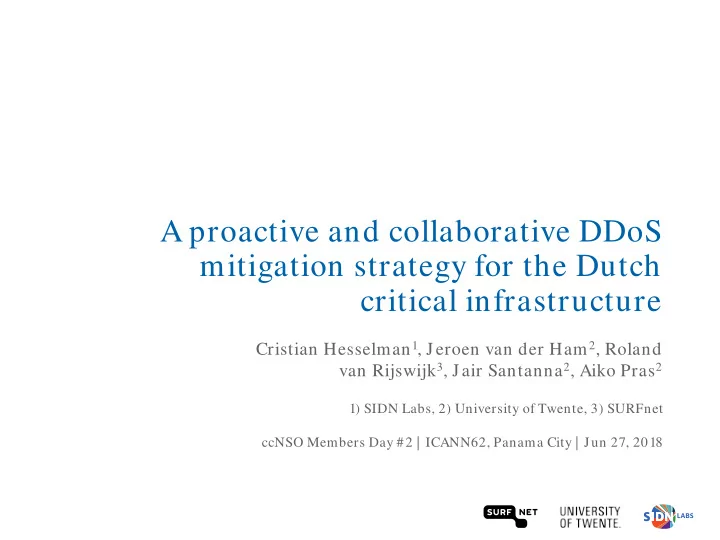

A proactive and collaborative DDoS mitigation strategy for the Dutch critical infrastructure Cristian Hesselman 1 , Jeroen van der Ham 2 , Roland van Rijswijk 3 , Jair Santanna 2 , Aiko Pras 2 1) SIDN Labs, 2) University of Twente, 3) SURFnet ccNSO Members Day #2 | ICANN62, Panama City | Jun 27, 2018
DDoS attacks (on the DNS) D1 D2 DNS server HN1 D3 ISP3 HN2 D4 swarm of globally distributed ISP1 compromised IoT devices ISP4 D5 HN3 D6 D7 ISP2 D9 HN4 Booter Control commands D8 DDoS flow HN = Home Network Other targets: OVH (hosting D = IoT device provider), Krebs On Security (website), Deutsche Telecom (ISP) https:/ / en.wikipedia.org/ wiki/ 2016_Dyn_cyberattack https:/ / www.zdnet.com/ article/ mirai-botnet-attack-briefly-knocked-an-entire-country-offline/
DDoS trends • Volume at 1+ Tbps, likely going up (Dyn @ 1.2 Tbps, GitHub @ 1.3 Tbps) • Many widely distributed DDoS sources (Mirai: 600K, bots all over the world) • IoT bots mutating and spreading quickly (Mirai: 75-minute doubling time) • Easier to launch through booters/ stressers (Mirai) • Combination of direct and reflection attacks (Mirai) • DNS increasingly a high-profile target (DNS root 2015, Dyn 2016)
The Netherlands • DDoS attacks on Dutch critical infrastructure operators (Jan 2018) • Estimated 40 Gbps attacks resulted in service outages at several operators • Reactive and individual DDoS mitigation strategy • (Commercial) DDoS protection services per critical service provider • Person-to-person incident response communications during attacks
A proactive and collaborative strategy • Improve information position of Dutch critical service providers by continually and autom atically sharing fingerprints of actual and potential DDoS sources • Widens view of critical service providers, enabling them to proactively prepare for attacks that have not hit them yet • Information provisioning layer that extends existing DDoS protection services that Dutch critical service providers use and does not replace them • Improve attribution of perpetrators and booter operators, allowing for better prosecution and increased deterrent effects • Onboard all critical providers in NL (Internet, financial, energy, water, etc.)
DDoS radar (IoT example) DPS1 IoT-powered Create fingerprint(A) DDoS attack A (rerouted to DPS1) Share fingerprint(A) CSP1 • IoT honeypots • Booter locators DDoS DDoS sensors radar Public Other Internet fingerprints CSP4 CSP3 Globally distributed CSP2 Use fingerprint(A) “swarm” of • DNS anycast adaptation compromised IoT • Update traffic filters devices • Adapt rules for DPS invocation DPS4 DPS3 DPS2 CSP = Critical Service Provider (e.g., a bank, ISP, or a registry) DPS = DDoS Protection Service (e.g., Nawas or commercial such as Arbor)
Fingerprint • Summary of DDoS traffic • Domain names used • Source IP addresses • Protocol • Packet length • Created from traffic capture files like PCAPs • Victim IP addresses not part of fingerprint • Challenge: creation at high speed (10s of Gbps)
Status and next steps • DDoS radar embraced by broad coalition of 25 players from industry (ISPs, xSPs, IXPs, banks, not-for-profit DPS) and gov’t (ministries and agencies) • Dutch Continuity Board (DCB) acts as springboard, supported by Dutch National Cyber Security Center (NCSC-NL) • Develop DDoS radar based on existing components, such as • DDoS-DB of the University of Twente (ddosdb.org) • NaWas’ DDoS pattern recognition system (ddos-patterns.net) • Working groups: (1) clearing house, (2) cross-industry information sharing, (3) outreach, (4) ground rules and incident response, and (5) exercises
Longer-term • Pilot part of an EU cybersecurity research project (under review) + development of a blueprint “business plan” to sustainably run (national) DDoS radars • Envisioned growth path: (1) Netherlands Europe global and (2) extend to “non-critical” service providers
Q&A Cristian Hesselm an Head of SIDN Labs +31 6 25 07 87 33 cristian.hesselman@sidn.nl @hesselma Blog: https:/ / www.sidnlabs.nl/ a/ news/ a-proactive-and- collaborative-ddos-mitigation-strategy-for-the-dutch-critical- infrastructure?language_id=2
Recommend
More recommend